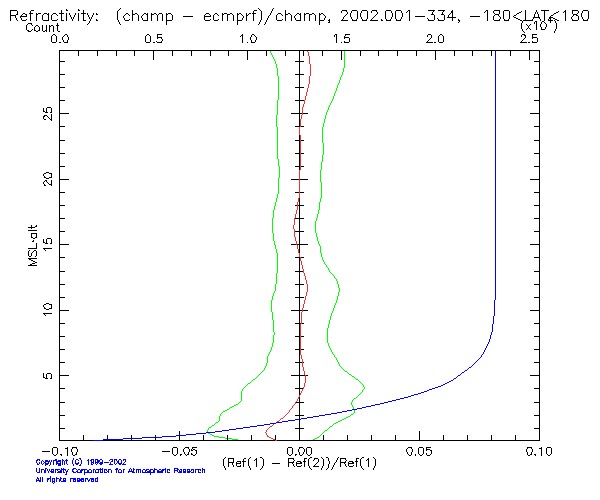Notice for CDAAC data users
Current radio occultation missions (CHAMP and SACC) are
experimental missions and their results have only preliminary
error characterization. More complete error characterization will be
available in future missions.
At present, for these missions, the quality of the retrieved
refractivity profiles in statistical sense can be characterized
through comparisons to other observational data, such as radiosondes
and atmospheric models. Such comparisons show the promise of these
data. Figure 1 shows a global refractivity comparison between the
ECMWF model and CDAAC-processed CHAMP from 2002. Comparison of the
GPS/MET data to atmospheric models and other observational data are
available in
Rocken et al., Analysis and validation of GPS/MET data
in the neutral atmosphere, JGR, 102, D25, 29,849-29,866, 1997
For CHAMP, see
Wickert, J., C. Reigber, G. Beyerle, R. Konig,
C. Marquardt, T. Schmidt, L. Grunwaldt, R. Galas, T.K. Meehan,
W.G. Melbourne and K. Hocke, Atmosphere Sounding by GPS Radio
Occultation: First Results from CHAMP (2001), GRL, 28, 3263
More publications on CHAMP and SACC
data are expected to appear in the near future.
Figure 1 -- 2002 refractivity comparison. CHAMP vs. ECMWF model

CDAAC data processing employs extensive quality control,
which is briefly outlined below.
Prior to inversion, an L1 Doppler model based on known GPS and LEO
orbits and refractivity climatology is computed and compared to the
observed Doppler. Large deviations, which commonly occur in the moist
troposphere, indicate tracking errors and are used for truncating
occultation data below that altitude. However, smaller tracking
errors, which are less common but may happen at any altitude, can still
affect the inversions.
In the lower troposphere, most occultations have low quality L2
signal that is not useable for ionospheric calibration. So, below a
certain altitude the L2 signal is no longer used. The quality of the
L2 signal and the altitude below which it is discarded are assessed
individually for each occultation. This assesment is based on a sharp
increase of L2 Doppler fluctuation and its mean deviation from L1
Doppler.
Along with each retrieved bending angle and refractivity
profile, CDAAC inversion
software provides a set of scalar parameters which can be
used to assess the quality of the occultation in
different respects. Below is a description of the most
important scalar parameters. In the future, additional scalar
parameters can be added.
- stdv (rad)
- Standard deviation of the observed ionosphere free bending
angle from climatology between 60 and 80 km (where the noise
overshadows the signal from the neutral atmosphere). The dominant
source of noise is the ionosphere and the magnitude of stdv
spans a rather large range. This parameter is used for optimal
estimation of the bending angle profile prior to the Abel
inversion.
[Sokolovskiy, S. and D. Hunt, Statistical Optimization
Approach for GPS/MET data inversions. URSI GPS/MET Workshop,
Tucson, AZ, 1996]:
alpha(h)=w(h)*alpha_obs(h)+[1-w(h)]*alpha_clim(h)
where alpha is the bending angle, h is the height
of ray asymptote.
Figure 2 -- Weighting functions w(h) for different magnitudes of stdv:
1) 1E-6; 2) 2E-6; 3) 5E-6; 4) 1E-5; 5) 2E-5; 6) 5E-5.

NOTE: The estimation of the weighting profile
which was formerly based on stdv alone is now more complex
in the newest version of ROAM.
[Lohmann, S. Statistical Optimization of Radio
Occultation Data with Dynamical Estimation of Error Covariances.
COSMIC science workshop, Taiwan 2004]
- smean (rad)
- Mean deviation of the observed ionosphere free bending
angle from climatology between 60 and 80 km. Normally (for
most occultations) smean is much smaller than stdv. If smean
is large (>~5E-5) and comparable to stdv, we don't recommend
using the occultation at high altitudes (>~20km).
- znid (km)
- Altitude below which the L2 signal has low quality and
is not used for the ionospheric calibration.
- S4
- Normalized standard deviation of the L1 signal amplitude at
high altitudes. If large, this indicates strong ionospheric
scintillation and may cause tracking errors on both L2 and L1
at all altitudes.
- difmaxion (rad)
- Maximal difference between L1 and L2 bending angles above
znid. If large, can indicate extreme ionospheric conditions
or L2 tracking errors.
difmaxref
Maximal fractional deviation of retrieved
refractivity from climatology (CIRA 86).
To determine which occultations to use, one can either rely
on the bad flag, which is set for each occultion based on the
values of the above scalar parameters (bad = 1 means don't use
this occultion!) or examine these parameters and make the right choice
for their particular situation. In general, stricter checking results
in fewer, but higher quality occultations. We recommend making the
decision based on histograms of the scalar parameters plotted for the
period of interest.
For those using the bad flag, here are the parameters used
in determining it:
- s4 > 0.1
- difmaxref > 0.3
- difmaxion > 0.001 rad
- stdv > 1.5e-4 rad
- abs(smean) > 1.0e-4 rad
If any of the above tests fail, then bad is set to 1 (TRUE)
We note that during some observational periods CHAMP and SACC
signals contain periodic phase modulation (1 sec and 5 sec spikes in
Doppler) which is not completely removed by filtering (tuned up to be
consistent, on average, with the Fresnel zone), and manifest itself as
periodic structures in the retrieved temperature profiles with period
~1-3 km, above the tropopause. If the data are intended for study of
the gravity waves, we recommend to contact the CDAAC team first.
|